Secure Spring REST API using OAuth2
来源:互联网 发布:性别就业歧视现状数据 编辑:程序博客网 时间:2024/05/23 15:55
http://websystique.com/spring-security/secure-spring-rest-api-using-oauth2/
Secure Spring REST API using OAuth2
Let’s secure our Spring REST API using OAuth2 this time, a simple guide showing what is required to secure a REST API using Spring OAuth2. Our use-case fits well with Resource-owner Password Grant flow of OAUth2 specification. We will use two different clients [Postman and a Spring RestTemplate based java application] to access our OAuth2 protected REST resources.
If you are already familiar with OAuth2 concepts, you may want to skip the theory, and jump right into code. As always, complete code can be found in attachment at the end of this article. Let’s get started.
- Spring Boot+AngularJS+Spring Data+Hibernate+MySQL CRUD App
- Spring Boot REST API Tutorial
- Spring Boot WAR deployment example
- Spring Boot Introduction + Hello World Example
- AngularJS+Spring Security using Basic Authentication
- Secure Spring REST API using Basic Authentication
What is OAuth2
OAuth2 is an standardized authorization protocol/framework. As per Official OAuth2 Specification:
The OAuth 2.0 authorization framework enables a third-party application to obtain limited access to an HTTP service, either on behalf of a resource owner by orchestrating an approval interaction between the resource owner and the HTTP service, or by allowing the third-party application to obtain access on its own behalf.
Big players like Google, Facebook and others are already using their own OAuth2 implementations for quite some time. Enterprises too are moving fast towards OAuth2 adoption.
I found OAuth2 specification rather simple to follow. Yet if you want to start even quickly, an excellent article on OAuth2 fundamentals can be found here which gives a deep insight in OAUth2 theoretical concepts.
Spring Security OAuth project provides all the necessary API we might need in order to develop an OAuth2 compliant implementation using Spring. Official Spring security oauth project provides a comprehensive example for implementing OAuth2. The code samples of this post is inspired by that examples itself. The intention of this post is to just use bare-minimum functionality required in order to secure our REST API, nothing more.
At minimum, you should be aware of four key concepts in OAuth2:
1. OAuth2 Roles
OAuth2 defines four roles:
resource owner:
Could be you. An entity capable of granting access to a protected resource. When the resource owner is a person, it is referred to as an end-user.resource server:
The server hosting the protected resources, capable of accepting and responding to protected resource requests using access tokens.client:
An application making protected resource requests on behalf of the resource owner and with its authorization. It could be a mobile app asking your permission to access your Facebook feeds, a REST client trying to access REST API, a web site [Stackoverflow e.g.] providing an alternative login option using Facebook account.authorization server:
The server issuing access tokens to the client after successfully authenticating the resource owner and obtaining authorization.
In our example, our REST API can only be accessed via Resource server which will require an access token to be present with request
2. OAuth2 Authorization Grant types
An authorization grant is a credential representing the resource owner’s authorization (to access its protected resources) used by the client to obtain an access token. The specification defines four grant types:
authorization codeimplicitresource owner password credentialsclient credentials
We will be using resource owner password credentials grant type. The reason is simple, we are not implementing a view which redirects us to a login page. Only the usage where a client [Postman or RestTemplate based Java client e.g.] have the Resource owner’s credentials and they provide those credential [along with client credentials] to authorization server in order to eventually receive the access-token[and optionally refresh token], and then use that token to actually access the resources.
A common example is the GMail app [a client] on your smartphone which takes your credentials and use them to connect to GMail servers. It also shows that ‘Password Credentials Grant’ is best suited when both the client and the servers are from same company as the trust is there, you don’t want to provide your credentials to a third party.
3. OAuth2 Tokens
Tokens are implementation specific random strings, generated by the authorization server and are issued when the client requests them.
Access Token: Sent with each request, usually valid for a very short life time [an hour e.g.]Refresh Token: Mainly used to get a new access token, not sent with each request, usually lives longer than access token.
HTTPS is a must have. Without HTTPS, no matter what your implementation is, security is vulnerable to be compromised.4. OAuth2 Access Token Scope
Client can ask for the resource with specific access rights using scope [want to access feeds & photos of this users facebook account], and authorization server in turn return scope showing what access rights were actually granted to the client [Resource owner only allowed feeds access, no photos e.g.].
Let’s Get into Code
Let’s implement the necessary building blocks to implement OAuth using Spring Security, in order to access our REST resources.
1. Resource Server
Resource Server hosts the resources [our REST API] the client is interested in. Resources are located on /user/.@EnableResourceServer annotation, applied on OAuth2 Resource Servers, enables a Spring Security filter that authenticates requests using an incoming OAuth2 token. Class ResourceServerConfigurerAdapter implementsResourceServerConfigurer providing methods to adjust the access rules and paths that are protected by OAuth2 security.
packagecom.websystique.springmvc.security;importorg.springframework.context.annotation.Configuration;importorg.springframework.security.config.annotation.web.builders.HttpSecurity;importorg.springframework.security.oauth2.config.annotation.web.configuration.EnableResourceServer;importorg.springframework.security.oauth2.config.annotation.web.configuration.ResourceServerConfigurerAdapter;importorg.springframework.security.oauth2.config.annotation.web.configurers.ResourceServerSecurityConfigurer;importorg.springframework.security.oauth2.provider.error.OAuth2AccessDeniedHandler;@Configuration@EnableResourceServerpublicclass ResourceServerConfiguration extendsResourceServerConfigurerAdapter { privatestatic final String RESOURCE_ID = "my_rest_api"; @Override publicvoid configure(ResourceServerSecurityConfigurer resources) { resources.resourceId(RESOURCE_ID).stateless(false); } @Override publicvoid configure(HttpSecurity http) throwsException { http. anonymous().disable() .requestMatchers().antMatchers("/user/**") .and().authorizeRequests() .antMatchers("/user/**").access("hasRole('ADMIN')") .and().exceptionHandling().accessDeniedHandler(newOAuth2AccessDeniedHandler()); }}2. Authorization Server
Authorization server is the one responsible for verifying credentials and if credentials are OK, providing the tokens[refresh-token as well as access-token]. It also contains information about registered clients and possible access scopes and grant types. The token store is used to store the token. We will be using an in-memory token store.@EnableAuthorizationServer enables an Authorization Server (i.e. an AuthorizationEndpoint and a TokenEndpoint) in the current application context. Class AuthorizationServerConfigurerAdapter implementsAuthorizationServerConfigurer which provides all the necessary methods to configure an Authorization server.
packagecom.websystique.springmvc.security;importorg.springframework.beans.factory.annotation.Autowired;importorg.springframework.beans.factory.annotation.Qualifier;importorg.springframework.context.annotation.Configuration;importorg.springframework.security.authentication.AuthenticationManager;importorg.springframework.security.oauth2.config.annotation.configurers.ClientDetailsServiceConfigurer;importorg.springframework.security.oauth2.config.annotation.web.configuration.AuthorizationServerConfigurerAdapter;importorg.springframework.security.oauth2.config.annotation.web.configuration.EnableAuthorizationServer;importorg.springframework.security.oauth2.config.annotation.web.configurers.AuthorizationServerEndpointsConfigurer;importorg.springframework.security.oauth2.config.annotation.web.configurers.AuthorizationServerSecurityConfigurer;importorg.springframework.security.oauth2.provider.approval.UserApprovalHandler;importorg.springframework.security.oauth2.provider.token.TokenStore;@Configuration@EnableAuthorizationServerpublicclass AuthorizationServerConfiguration extendsAuthorizationServerConfigurerAdapter { privatestatic String REALM="MY_OAUTH_REALM"; @Autowired privateTokenStore tokenStore; @Autowired privateUserApprovalHandler userApprovalHandler; @Autowired @Qualifier("authenticationManagerBean") privateAuthenticationManager authenticationManager; @Override publicvoid configure(ClientDetailsServiceConfigurer clients) throwsException { clients.inMemory() .withClient("my-trusted-client") .authorizedGrantTypes("password","authorization_code","refresh_token","implicit") .authorities("ROLE_CLIENT","ROLE_TRUSTED_CLIENT") .scopes("read","write","trust") .secret("secret") .accessTokenValiditySeconds(120).//Access token is only valid for 2 minutes. refreshTokenValiditySeconds(600);//Refresh token is only valid for 10 minutes. } @Override publicvoid configure(AuthorizationServerEndpointsConfigurer endpoints) throwsException { endpoints.tokenStore(tokenStore).userApprovalHandler(userApprovalHandler) .authenticationManager(authenticationManager); } @Override publicvoid configure(AuthorizationServerSecurityConfigurer oauthServer) throwsException { oauthServer.realm(REALM+"/client"); }}Above configuration
- Registers a client with client-id ‘my-trusted-client’ and password ‘secret’ and roles & scope he is allowed for.
- Specifies that any generated access token will be valid for only 120 seconds
- Specifies that any generated refresh token will be valid for only 600 seconds
3. Security Configuration
Gluing everything together. Endpoint /oauth/token is used to request a token [access or refresh]. Resource owners [bill,bob] are configured here itself.
packagecom.websystique.springmvc.security;importorg.springframework.beans.factory.annotation.Autowired;importorg.springframework.context.annotation.Bean;importorg.springframework.context.annotation.Configuration;importorg.springframework.security.authentication.AuthenticationManager;importorg.springframework.security.config.annotation.authentication.builders.AuthenticationManagerBuilder;importorg.springframework.security.config.annotation.web.builders.HttpSecurity;importorg.springframework.security.config.annotation.web.configuration.EnableWebSecurity;importorg.springframework.security.config.annotation.web.configuration.WebSecurityConfigurerAdapter;importorg.springframework.security.oauth2.provider.ClientDetailsService;importorg.springframework.security.oauth2.provider.approval.ApprovalStore;importorg.springframework.security.oauth2.provider.approval.TokenApprovalStore;importorg.springframework.security.oauth2.provider.approval.TokenStoreUserApprovalHandler;importorg.springframework.security.oauth2.provider.request.DefaultOAuth2RequestFactory;importorg.springframework.security.oauth2.provider.token.TokenStore;importorg.springframework.security.oauth2.provider.token.store.InMemoryTokenStore;@Configuration@EnableWebSecuritypublicclass OAuth2SecurityConfiguration extendsWebSecurityConfigurerAdapter { @Autowired privateClientDetailsService clientDetailsService; @Autowired publicvoid globalUserDetails(AuthenticationManagerBuilder auth) throwsException { auth.inMemoryAuthentication() .withUser("bill").password("abc123").roles("ADMIN").and() .withUser("bob").password("abc123").roles("USER"); } @Override protectedvoid configure(HttpSecurity http) throwsException { http .csrf().disable() .anonymous().disable() .authorizeRequests() .antMatchers("/oauth/token").permitAll(); } @Override @Bean publicAuthenticationManager authenticationManagerBean() throwsException { returnsuper.authenticationManagerBean(); } @Bean publicTokenStore tokenStore() { returnnew InMemoryTokenStore(); } @Bean @Autowired publicTokenStoreUserApprovalHandler userApprovalHandler(TokenStore tokenStore){ TokenStoreUserApprovalHandler handler = newTokenStoreUserApprovalHandler(); handler.setTokenStore(tokenStore); handler.setRequestFactory(newDefaultOAuth2RequestFactory(clientDetailsService)); handler.setClientDetailsService(clientDetailsService); returnhandler; } @Bean @Autowired publicApprovalStore approvalStore(TokenStore tokenStore) throwsException { TokenApprovalStore store = newTokenApprovalStore(); store.setTokenStore(tokenStore); returnstore; } }Additionally, enable Global method security which will activate @PreFilter, @PostFilter, @PreAuthorize @PostAuthorize annotations if we want to use them.
packagecom.websystique.springmvc.security;importorg.springframework.beans.factory.annotation.Autowired;importorg.springframework.context.annotation.Configuration;importorg.springframework.security.access.expression.method.MethodSecurityExpressionHandler;importorg.springframework.security.config.annotation.method.configuration.EnableGlobalMethodSecurity;importorg.springframework.security.config.annotation.method.configuration.GlobalMethodSecurityConfiguration;importorg.springframework.security.oauth2.provider.expression.OAuth2MethodSecurityExpressionHandler;@Configuration@EnableGlobalMethodSecurity(prePostEnabled = true, proxyTargetClass = true)publicclass MethodSecurityConfig extendsGlobalMethodSecurityConfiguration { @Autowired privateOAuth2SecurityConfiguration securityConfig; @Override protectedMethodSecurityExpressionHandler createExpressionHandler() { returnnew OAuth2MethodSecurityExpressionHandler(); }}4. Endpoints and their purpose
- Attempt to access resources [REST API] without any authorization [will fail of-course].
GET http://localhost:8080/SpringSecurityOAuth2Example/user/ - Ask for tokens[access+refresh] using HTTP POST on
/oauth/token, with grant_type=password,and resource owners credentials as req-params. Additionally, send client credentials in Authorization header.POST http://localhost:8080/SpringSecurityOAuth2Example/oauth/token?grant_type=password&username=bill&password=abc123 - Ask for a new access token via valid refresh-token, using HTTP POST on
/oauth/token, with grant_type=refresh_token,and sending actual refresh token. Additionally, send client credentials in Authorization header.POST http://localhost:8080/SpringSecurityOAuth2Example/oauth/token?grant_type=refresh_token&refresh_token=094b7d23-973f-4cc1-83ad-8ffd43de1845 - Access the resource by providing an access token using
access_tokenquery param with request.GET http://localhost:8080/SpringSecurityOAuth2Example/user/?access_token=3525d0e4-d881-49e7-9f91-bcfd18259109
5. Rest API
The simple Spring REST API i used in most of my posts.
packagecom.websystique.springmvc.controller; importjava.util.List; importorg.springframework.beans.factory.annotation.Autowired;importorg.springframework.http.HttpHeaders;importorg.springframework.http.HttpStatus;importorg.springframework.http.MediaType;importorg.springframework.http.ResponseEntity;importorg.springframework.web.bind.annotation.PathVariable;importorg.springframework.web.bind.annotation.RequestBody;importorg.springframework.web.bind.annotation.RequestMapping;importorg.springframework.web.bind.annotation.RequestMethod;importorg.springframework.web.bind.annotation.RestController;importorg.springframework.web.util.UriComponentsBuilder; importcom.websystique.springmvc.model.User;importcom.websystique.springmvc.service.UserService; @RestControllerpublicclass HelloWorldRestController { @Autowired UserService userService; //Service which will do all data retrieval/manipulation work //-------------------Retrieve All Users-------------------------------------------------------- @RequestMapping(value = "/user/", method = RequestMethod.GET) publicResponseEntity<List<User>> listAllUsers() { List<User> users = userService.findAllUsers(); if(users.isEmpty()){ returnnew ResponseEntity<List<User>>(HttpStatus.NO_CONTENT);//You many decide to return HttpStatus.NOT_FOUND } returnnew ResponseEntity<List<User>>(users, HttpStatus.OK); } //-------------------Retrieve Single User-------------------------------------------------------- @RequestMapping(value = "/user/{id}", method = RequestMethod.GET, produces = {MediaType.APPLICATION_JSON_VALUE,MediaType.APPLICATION_XML_VALUE}) publicResponseEntity<User> getUser(@PathVariable("id")longid) { System.out.println("Fetching User with id " + id); User user = userService.findById(id); if(user == null) { System.out.println("User with id " + id + " not found"); returnnew ResponseEntity<User>(HttpStatus.NOT_FOUND); } returnnew ResponseEntity<User>(user, HttpStatus.OK); } //-------------------Create a User-------------------------------------------------------- @RequestMapping(value = "/user/", method = RequestMethod.POST) publicResponseEntity<Void> createUser(@RequestBodyUser user, UriComponentsBuilder ucBuilder) { System.out.println("Creating User " + user.getName()); if(userService.isUserExist(user)) { System.out.println("A User with name " + user.getName() + " already exist"); returnnew ResponseEntity<Void>(HttpStatus.CONFLICT); } userService.saveUser(user); HttpHeaders headers = newHttpHeaders(); headers.setLocation(ucBuilder.path("/user/{id}").buildAndExpand(user.getId()).toUri()); returnnew ResponseEntity<Void>(headers, HttpStatus.CREATED); } //------------------- Update a User -------------------------------------------------------- @RequestMapping(value = "/user/{id}", method = RequestMethod.PUT) publicResponseEntity<User> updateUser(@PathVariable("id")longid, @RequestBodyUser user) { System.out.println("Updating User " + id); User currentUser = userService.findById(id); if(currentUser==null) { System.out.println("User with id " + id + " not found"); returnnew ResponseEntity<User>(HttpStatus.NOT_FOUND); } currentUser.setName(user.getName()); currentUser.setAge(user.getAge()); currentUser.setSalary(user.getSalary()); userService.updateUser(currentUser); returnnew ResponseEntity<User>(currentUser, HttpStatus.OK); } //------------------- Delete a User -------------------------------------------------------- @RequestMapping(value = "/user/{id}", method = RequestMethod.DELETE) publicResponseEntity<User> deleteUser(@PathVariable("id")longid) { System.out.println("Fetching & Deleting User with id " + id); User user = userService.findById(id); if(user == null) { System.out.println("Unable to delete. User with id " + id + " not found"); returnnew ResponseEntity<User>(HttpStatus.NOT_FOUND); } userService.deleteUserById(id); returnnew ResponseEntity<User>(HttpStatus.NO_CONTENT); } //------------------- Delete All Users -------------------------------------------------------- @RequestMapping(value = "/user/", method = RequestMethod.DELETE) publicResponseEntity<User> deleteAllUsers() { System.out.println("Deleting All Users"); userService.deleteAllUsers(); returnnew ResponseEntity<User>(HttpStatus.NO_CONTENT); } }6. Running the application
Run it and test it using two different clients.
Client 1: Postman
Try to access a resource without any auth info, wil get a 401.
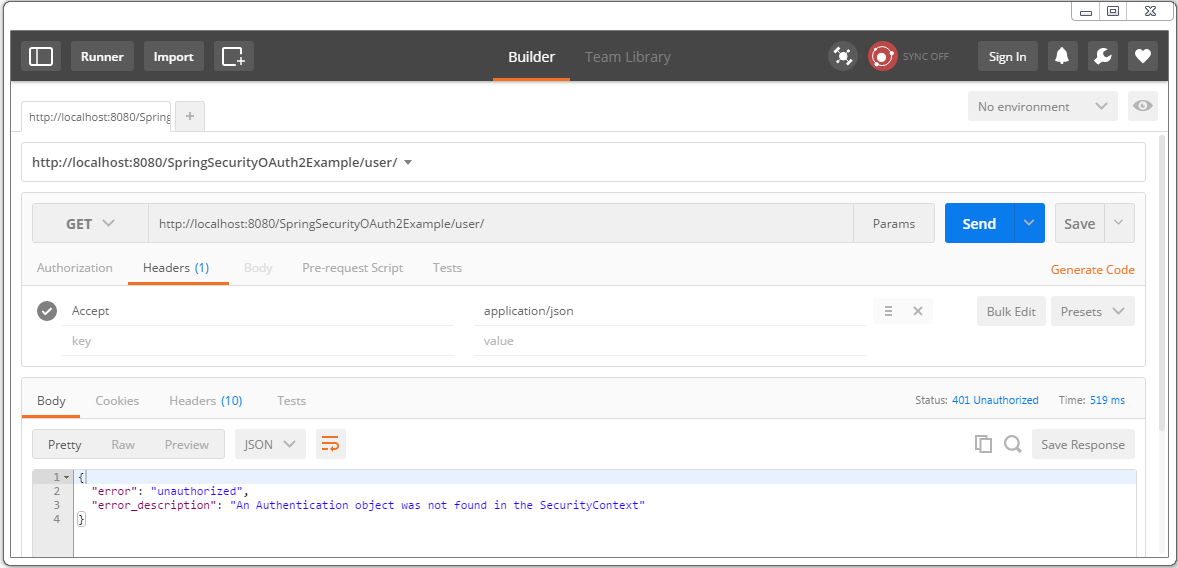
Let’s get the tokens. First add an authorization header with client credentials [my-trusted-client/secret].
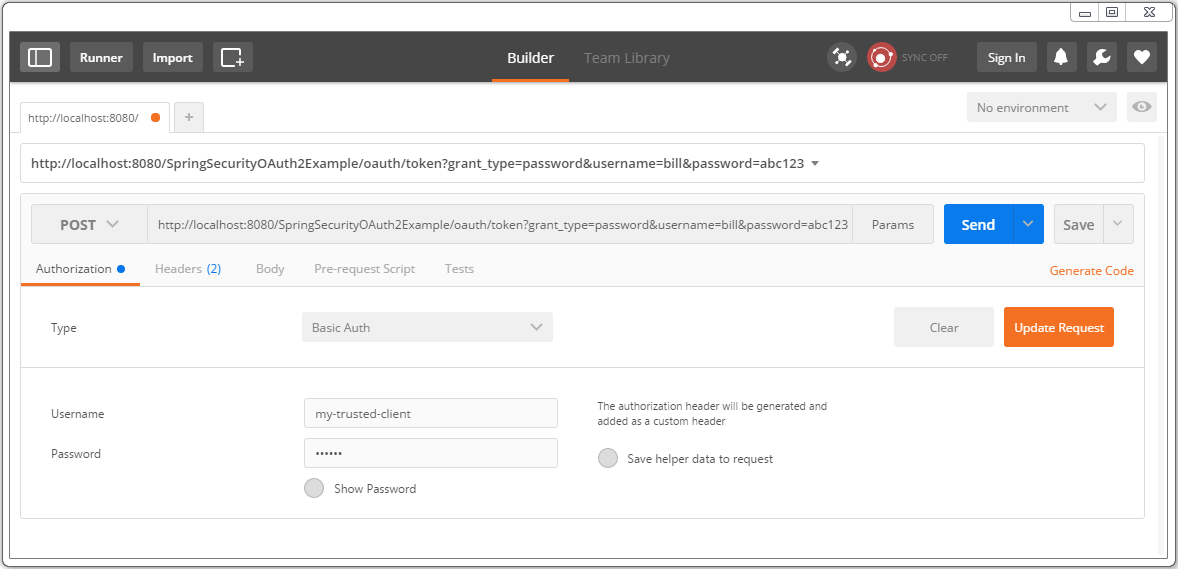
Click on update request, verify the header in header-tab.
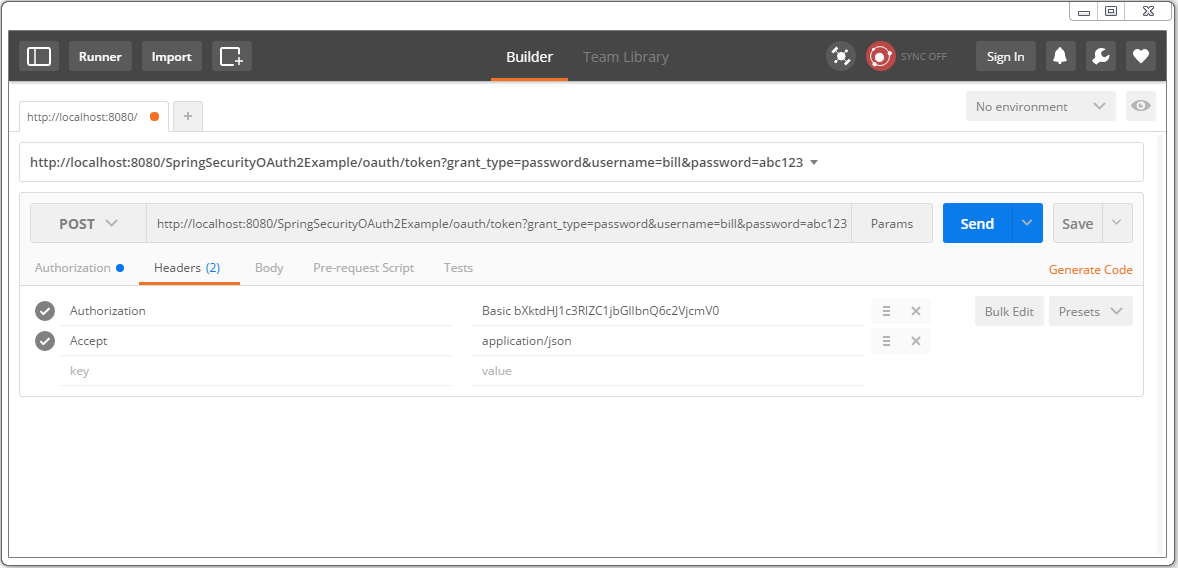
Send the Post request, you should receive the response containing access-token as well as refresh-token.
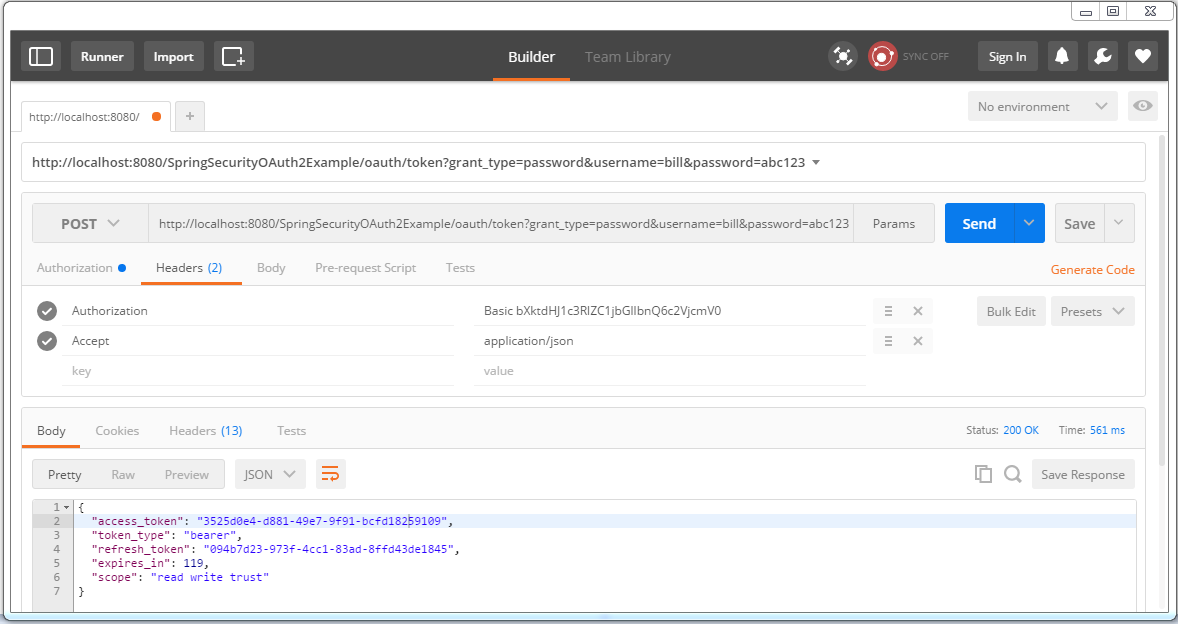
Save these tokens somewhere, you will need them. Now you can use this access-token [valid for 2 minutes] to access resources.
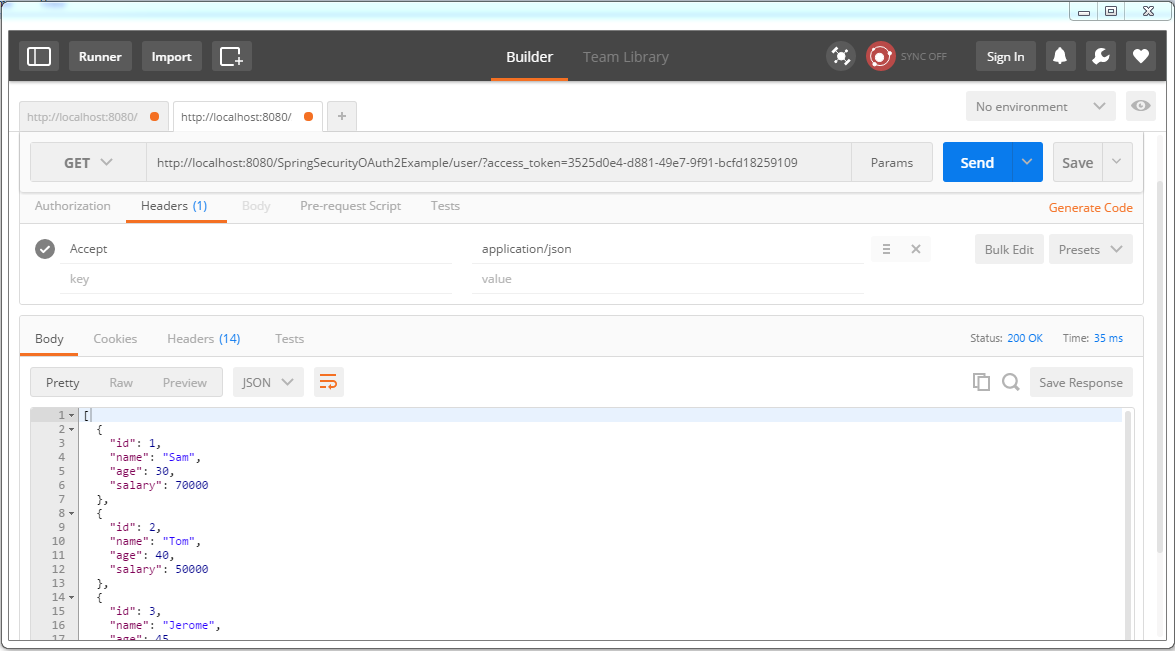
After 2 minutes, access-token gets expired, your further resource requests will fail.
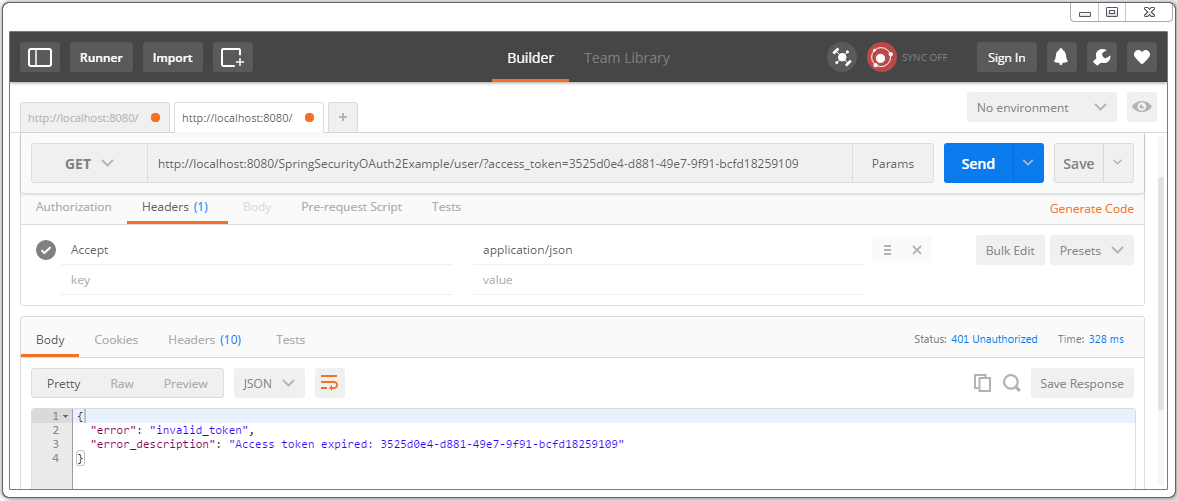
We need a new access-token. Fire a post to with refresh-token to get a brand-new access-token.
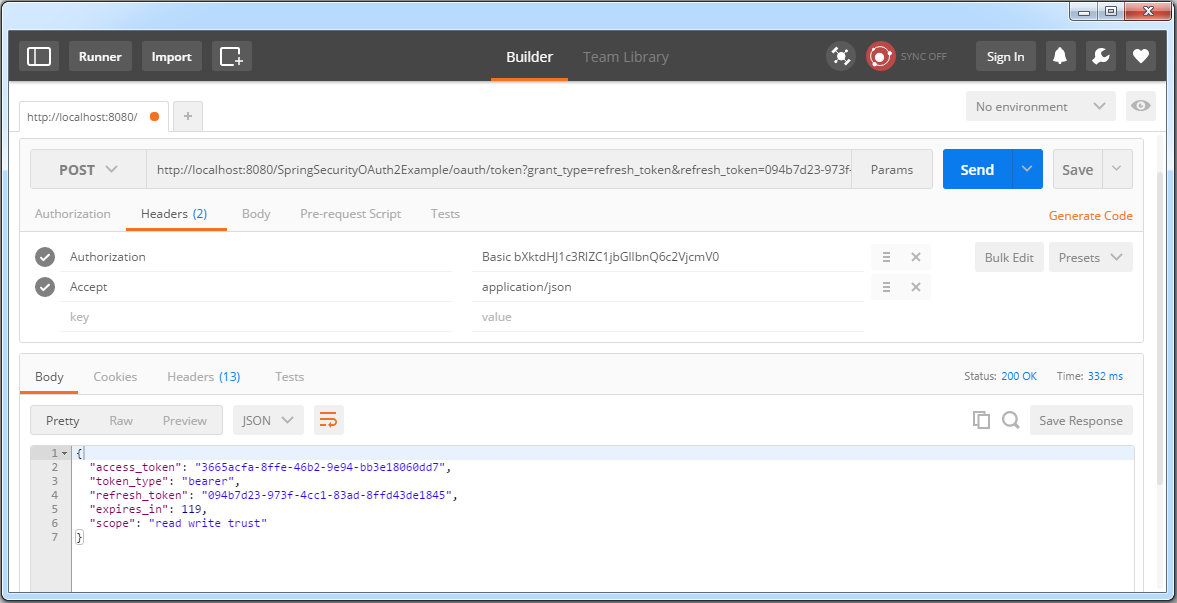
Use this new access-token to access the resources.
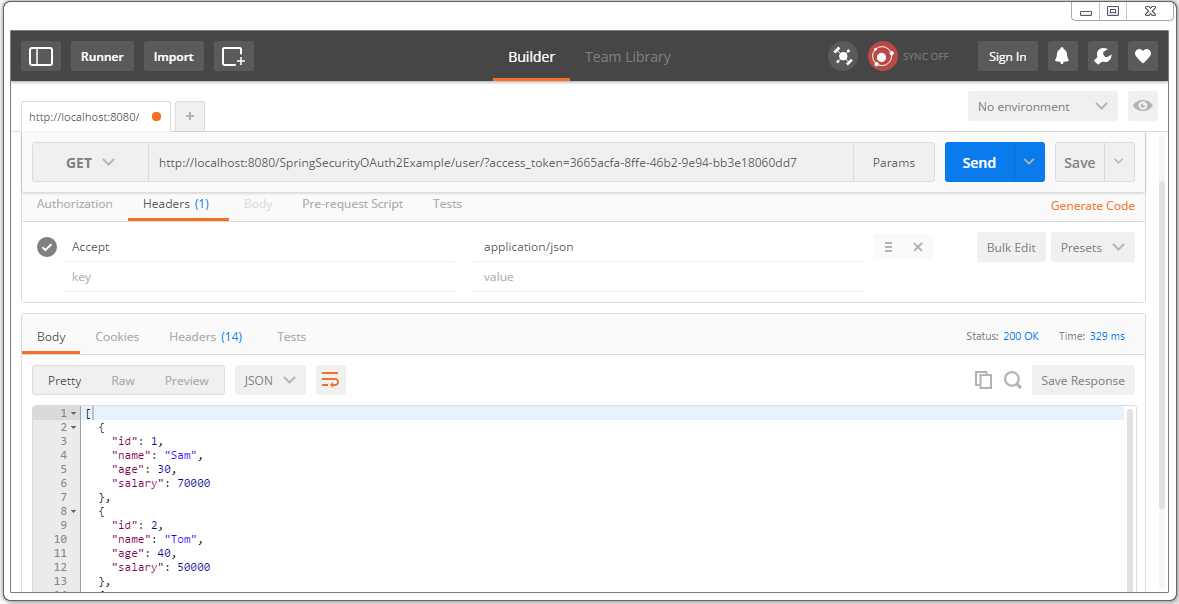
Refresh-token expires too[10 minutes]. After that, you should see your refresh request getting failed.
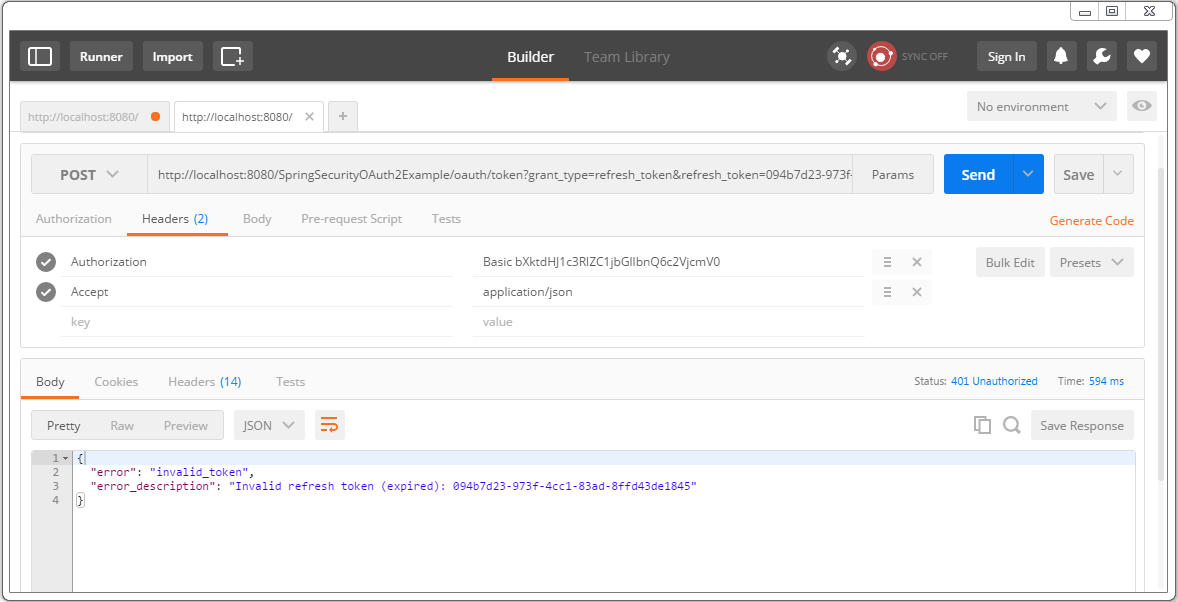
It means you need to request a new refresh+access-token, as in step 2.
Client 2: RestTemplate based java application
Method sendTokenRequest is used to actually get the tokens. The access-token we got in response is then used with each request. If required, You can implement the refresh-token flow easily in below example.
packagecom.websystique.springmvc; importjava.net.URI;importjava.util.Arrays;importjava.util.LinkedHashMap;importjava.util.List;importorg.apache.commons.codec.binary.Base64;importorg.springframework.http.HttpEntity;importorg.springframework.http.HttpHeaders;importorg.springframework.http.HttpMethod;importorg.springframework.http.MediaType;importorg.springframework.http.ResponseEntity;importorg.springframework.util.Assert;importorg.springframework.web.client.RestTemplate;importcom.websystique.springmvc.model.AuthTokenInfo;importcom.websystique.springmvc.model.User; publicclass SpringRestClient { publicstatic final String REST_SERVICE_URI = "http://localhost:8080/SpringSecurityOAuth2Example"; publicstatic final String AUTH_SERVER_URI = "http://localhost:8080/SpringSecurityOAuth2Example/oauth/token"; publicstatic final String QPM_PASSWORD_GRANT = "?grant_type=password&username=bill&password=abc123"; publicstatic final String QPM_ACCESS_TOKEN = "?access_token="; /* * Prepare HTTP Headers. */ privatestatic HttpHeaders getHeaders(){ HttpHeaders headers = newHttpHeaders(); headers.setAccept(Arrays.asList(MediaType.APPLICATION_JSON)); returnheaders; } /* * Add HTTP Authorization header, using Basic-Authentication to send client-credentials. */ privatestatic HttpHeaders getHeadersWithClientCredentials(){ String plainClientCredentials="my-trusted-client:secret"; String base64ClientCredentials = newString(Base64.encodeBase64(plainClientCredentials.getBytes())); HttpHeaders headers = getHeaders(); headers.add("Authorization","Basic " + base64ClientCredentials); returnheaders; } /* * Send a POST request [on /oauth/token] to get an access-token, which will then be send with each request. */ @SuppressWarnings({"unchecked"}) privatestatic AuthTokenInfo sendTokenRequest(){ RestTemplate restTemplate = newRestTemplate(); HttpEntity<String> request = newHttpEntity<String>(getHeadersWithClientCredentials()); ResponseEntity<Object> response = restTemplate.exchange(AUTH_SERVER_URI+QPM_PASSWORD_GRANT, HttpMethod.POST, request, Object.class); LinkedHashMap<String, Object> map = (LinkedHashMap<String, Object>)response.getBody(); AuthTokenInfo tokenInfo = null; if(map!=null){ tokenInfo = newAuthTokenInfo(); tokenInfo.setAccess_token((String)map.get("access_token")); tokenInfo.setToken_type((String)map.get("token_type")); tokenInfo.setRefresh_token((String)map.get("refresh_token")); tokenInfo.setExpires_in((int)map.get("expires_in")); tokenInfo.setScope((String)map.get("scope")); System.out.println(tokenInfo); //System.out.println("access_token ="+map.get("access_token")+", token_type="+map.get("token_type")+", refresh_token="+map.get("refresh_token") //+", expires_in="+map.get("expires_in")+", scope="+map.get("scope"));; }else{ System.out.println("No user exist----------"); } returntokenInfo; } /* * Send a GET request to get list of all users. */ @SuppressWarnings({"unchecked","rawtypes"}) privatestatic void listAllUsers(AuthTokenInfo tokenInfo){ Assert.notNull(tokenInfo,"Authenticate first please......"); System.out.println("\nTesting listAllUsers API-----------"); RestTemplate restTemplate = newRestTemplate(); HttpEntity<String> request = newHttpEntity<String>(getHeaders()); ResponseEntity<List> response = restTemplate.exchange(REST_SERVICE_URI+"/user/"+QPM_ACCESS_TOKEN+tokenInfo.getAccess_token(), HttpMethod.GET, request, List.class); List<LinkedHashMap<String, Object>> usersMap = (List<LinkedHashMap<String, Object>>)response.getBody(); if(usersMap!=null){ for(LinkedHashMap<String, Object> map : usersMap){ System.out.println("User : id="+map.get("id")+", Name="+map.get("name")+", Age="+map.get("age")+", Salary="+map.get("salary"));; } }else{ System.out.println("No user exist----------"); } } /* * Send a GET request to get a specific user. */ privatestatic void getUser(AuthTokenInfo tokenInfo){ Assert.notNull(tokenInfo,"Authenticate first please......"); System.out.println("\nTesting getUser API----------"); RestTemplate restTemplate = newRestTemplate(); HttpEntity<String> request = newHttpEntity<String>(getHeaders()); ResponseEntity<User> response = restTemplate.exchange(REST_SERVICE_URI+"/user/1"+QPM_ACCESS_TOKEN+tokenInfo.getAccess_token(), HttpMethod.GET, request, User.class); User user = response.getBody(); System.out.println(user); } /* * Send a POST request to create a new user. */ privatestatic void createUser(AuthTokenInfo tokenInfo) { Assert.notNull(tokenInfo,"Authenticate first please......"); System.out.println("\nTesting create User API----------"); RestTemplate restTemplate = newRestTemplate(); User user = newUser(0,"Sarah",51,134); HttpEntity<Object> request = newHttpEntity<Object>(user, getHeaders()); URI uri = restTemplate.postForLocation(REST_SERVICE_URI+"/user/"+QPM_ACCESS_TOKEN+tokenInfo.getAccess_token(), request, User.class); System.out.println("Location : "+uri.toASCIIString()); } /* * Send a PUT request to update an existing user. */ privatestatic void updateUser(AuthTokenInfo tokenInfo) { Assert.notNull(tokenInfo,"Authenticate first please......"); System.out.println("\nTesting update User API----------"); RestTemplate restTemplate = newRestTemplate(); User user = newUser(1,"Tomy",33,70000); HttpEntity<Object> request = newHttpEntity<Object>(user, getHeaders()); ResponseEntity<User> response = restTemplate.exchange(REST_SERVICE_URI+"/user/1"+QPM_ACCESS_TOKEN+tokenInfo.getAccess_token(), HttpMethod.PUT, request, User.class); System.out.println(response.getBody()); } /* * Send a DELETE request to delete a specific user. */ privatestatic void deleteUser(AuthTokenInfo tokenInfo) { Assert.notNull(tokenInfo,"Authenticate first please......"); System.out.println("\nTesting delete User API----------"); RestTemplate restTemplate = newRestTemplate(); HttpEntity<String> request = newHttpEntity<String>(getHeaders()); restTemplate.exchange(REST_SERVICE_URI+"/user/3"+QPM_ACCESS_TOKEN+tokenInfo.getAccess_token(), HttpMethod.DELETE, request, User.class); } /* * Send a DELETE request to delete all users. */ privatestatic void deleteAllUsers(AuthTokenInfo tokenInfo) { Assert.notNull(tokenInfo,"Authenticate first please......"); System.out.println("\nTesting all delete Users API----------"); RestTemplate restTemplate = newRestTemplate(); HttpEntity<String> request = newHttpEntity<String>(getHeaders()); restTemplate.exchange(REST_SERVICE_URI+"/user/"+QPM_ACCESS_TOKEN+tokenInfo.getAccess_token(), HttpMethod.DELETE, request, User.class); } publicstatic void main(String args[]){ AuthTokenInfo tokenInfo = sendTokenRequest(); listAllUsers(tokenInfo); getUser(tokenInfo); createUser(tokenInfo); listAllUsers(tokenInfo); updateUser(tokenInfo); listAllUsers(tokenInfo); deleteUser(tokenInfo); listAllUsers(tokenInfo); deleteAllUsers(tokenInfo); listAllUsers(tokenInfo); }}Above code will produce following output:
AuthTokenInfo [access_token=fceed386-5923-4bf8-b193-1d76f95da4c4, token_type=bearer, refresh_token=29d28ee2-9d09-483f-a2d6-7f93e7a31667, expires_in=71, scope=read write trust]Testing listAllUsers API-----------User : id=1, Name=Sam, Age=30, Salary=70000.0User : id=2, Name=Tom, Age=40, Salary=50000.0User : id=3, Name=Jerome, Age=45, Salary=30000.0User : id=4, Name=Silvia, Age=50, Salary=40000.0Testing getUser API----------User [id=1, name=Sam, age=30, salary=70000.0]Testing create User API----------Location : http://localhost:8080/SpringSecurityOAuth2Example/user/5Testing listAllUsers API-----------User : id=1, Name=Sam, Age=30, Salary=70000.0User : id=2, Name=Tom, Age=40, Salary=50000.0User : id=3, Name=Jerome, Age=45, Salary=30000.0User : id=4, Name=Silvia, Age=50, Salary=40000.0User : id=5, Name=Sarah, Age=51, Salary=134.0Testing update User API----------User [id=1, name=Tomy, age=33, salary=70000.0]Testing listAllUsers API-----------User : id=1, Name=Tomy, Age=33, Salary=70000.0User : id=2, Name=Tom, Age=40, Salary=50000.0User : id=3, Name=Jerome, Age=45, Salary=30000.0User : id=4, Name=Silvia, Age=50, Salary=40000.0User : id=5, Name=Sarah, Age=51, Salary=134.0Testing delete User API----------Testing listAllUsers API-----------User : id=1, Name=Tomy, Age=33, Salary=70000.0User : id=2, Name=Tom, Age=40, Salary=50000.0User : id=4, Name=Silvia, Age=50, Salary=40000.0User : id=5, Name=Sarah, Age=51, Salary=134.0Testing all delete Users API----------Testing listAllUsers API-----------No user exist----------Project Structure
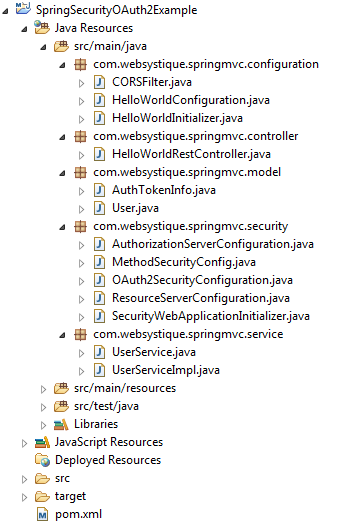
pom.xml
<projectxmlns="http://maven.apache.org/POM/4.0.0"xmlns:xsi="http://www.w3.org/2001/XMLSchema-instance" xsi:schemaLocation="http://maven.apache.org/POM/4.0.0http://maven.apache.org/xsd/maven-4.0.0.xsd"> <modelVersion>4.0.0</modelVersion> <groupId>com.websystique.springmvc</groupId> <artifactId>SpringSecurityOAuth2Example</artifactId> <version>1.0.0</version> <packaging>war</packaging> <name>SpringSecurityOAuth2Example</name> <properties> <project.build.sourceEncoding>UTF-8</project.build.sourceEncoding> <springframework.version>4.3.1.RELEASE</springframework.version> <springsecurity.version>4.1.1.RELEASE</springsecurity.version> <springsecurityoauth2.version>2.0.10.RELEASE</springsecurityoauth2.version> <jackson.library>2.7.5</jackson.library> </properties> <dependencies> <!-- Spring --> <dependency> <groupId>org.springframework</groupId> <artifactId>spring-core</artifactId> <version>${springframework.version}</version> </dependency> <dependency> <groupId>org.springframework</groupId> <artifactId>spring-web</artifactId> <version>${springframework.version}</version> </dependency> <dependency> <groupId>org.springframework</groupId> <artifactId>spring-webmvc</artifactId> <version>${springframework.version}</version> </dependency> <!-- Spring Security --> <dependency> <groupId>org.springframework.security</groupId> <artifactId>spring-security-web</artifactId> <version>${springsecurity.version}</version> </dependency> <dependency> <groupId>org.springframework.security</groupId> <artifactId>spring-security-config</artifactId> <version>${springsecurity.version}</version> </dependency> <!-- Spring Security OAuth2--> <dependency> <groupId>org.springframework.security.oauth</groupId> <artifactId>spring-security-oauth2</artifactId> <version>${springsecurityoauth2.version}</version> </dependency> <!-- Jackson libraries --> <dependency> <groupId>com.fasterxml.jackson.core</groupId> <artifactId>jackson-databind</artifactId> <version>${jackson.library}</version> </dependency> <dependency> <groupId>com.fasterxml.jackson.dataformat</groupId> <artifactId>jackson-dataformat-xml</artifactId> <version>${jackson.library}</version> </dependency> <dependency> <groupId>javax.servlet</groupId> <artifactId>javax.servlet-api</artifactId> <version>3.1.0</version> </dependency> </dependencies> <build> <plugins> <plugin> <groupId>org.apache.maven.plugins</groupId> <artifactId>maven-compiler-plugin</artifactId> <version>3.2</version> <configuration> <source>1.7</source> <target>1.7</target> </configuration> </plugin> <plugin> <groupId>org.apache.maven.plugins</groupId> <artifactId>maven-war-plugin</artifactId> <version>2.4</version> <configuration> <warSourceDirectory>src/main/webapp</warSourceDirectory> <warName>SpringSecurityOAuth2Example</warName> <failOnMissingWebXml>false</failOnMissingWebXml> </configuration> </plugin> </plugins> <finalName>SpringSecurityOAuth2Example</finalName> </build></project>Download Source Code
References
- OAuth2 Specification
- Spring OAuth2 Official reference
- Spring Security 4 Project Page
- Spring Security 4 Reference Manual
- Secure Spring REST API using OAuth2
- Secure Spring REST API using OAuth2
- Secure Spring REST API使用OAuth2
- Secure REST API with oauth2 (翻译)
- Secure REST API with oauth2 (翻译)
- 【转】Spring+Spring Security+OAuth2实现REST API权限控制
- Spring+Spring Security+OAuth2实现REST API权限控制
- Spring REST API整理
- spring mvc 创建 rest api
- Spring Security 4 Rest API
- WP REST API: Setting Up and Using Basic Authentication
- 使用Spring MVC创建REST API
- Spring Boot REST API错误处理指南
- OAuth2 & Spring Security OAuth2 总结
- Embedded Jetty and Apache CXF: secure REST services with Spring Security
- salesforce rest api 登录 | Authenticating to Salesforce using REST, OAuth 2.0 and Java
- api安全-----oauth2&jwt
- REST API
- centos系统有多个内核,修改默认启动内核
- MyBatis--关联关系查询--自关联--一对多--查询指定父节点的所有子节点
- JAVA开源爬虫列表及简介
- 常见浏览器兼容性问题与解决方案
- 数据库学习
- Secure Spring REST API using OAuth2
- myeclipse引入MySQL数据库文件.sql 无法打开问题
- Linux--RH124---unit 10 系统日志
- ETL工具实现不同数据库迁移
- Error:Execution failed for task ':app:prepareDebugAndroidTestDependencies'. > Dependency Error解决方法
- unity的Asset server提示admin不存在的解决办法
- 全球首份AR报告第二章:AR的工作原理
- PyTianQiService天气获取服务项目
- Mybatis开发总结


